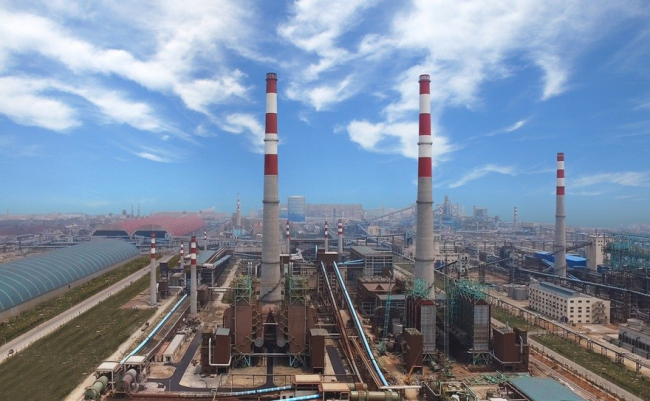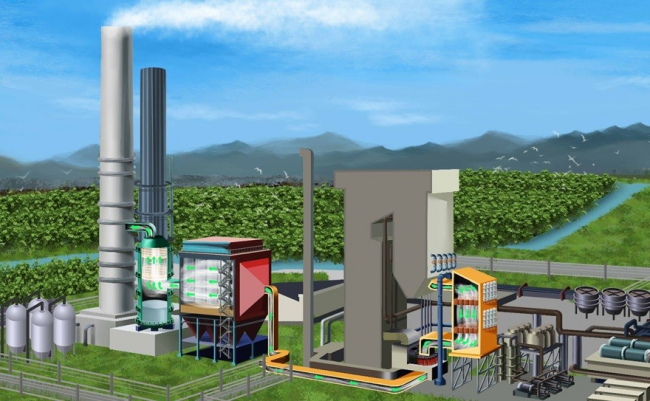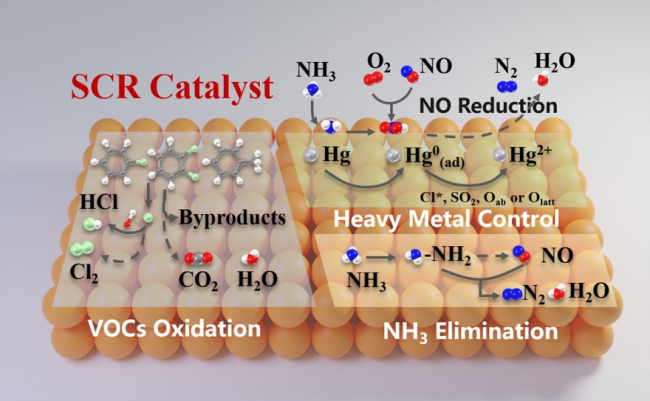Tsinghua researchers are at the forefront of industrial pollution mitigation, helping set emissions benchmarks and exporting their systems to the world.
For a hazy fortnight in 2013, China made global headlines when record air pollution levels around the country sparked major public health concerns. Today, Chinese technologies enable the enforcement of coal-fired power and industrial furnace emissions standards that are much more stringent than those in the United States or European Union. The country has also become a major exporter of emissions-reducing industrial flue gas treatment systems.
Professor Junhua Li runs a key flue gas treatment project through Tsinghua's School of the Environment, and he is leading China's industrial emission-reduction effort. His group's focus has been selective catalytic reduction systems to remove ozone-depleting, smog-inducing and acid rain-causing nitrogen oxides, which are major air pollutants produced by several industries, including coal-fired power.
Produced by the combustion of coal, petroleum, natural gas, and other fossil fuels, nitrogen oxides are being tackled with everything from vanadium pentoxide catalysts to specific performance parameters of ammonia escape, explains Li. Between 2013 and 2017, China moved to the point where denitrification systems were used in 92% of its coal-fired power plants.
“Our solutions have already helped both to set and fulfill very ambitious national targets,” Li points out,“ including loweringnitrogen oxides emissions by 17% between 2013 and 2017”.

This Baosteel plant in China must make sure its nitrogen oxides emissions comply with new ‘ultra-low’ 50 mg/m3 emission criteria by 2025.
Since 2014 China has also required nitrogen oxides emissions of less than 50 mg/m3 for newly built power plants, compared to 95 mg/m3 in the United States and 150 mg/m3 in the European Union.
Withnearly half of the world’s total installed capacity of coal-fired power, the size of China’s industry makes it viable and expedient to develop and implement its own, sometimes tighter, environmental standards, explains Li. These, he says, can better adapt to the country’s unique technical needs and conditions, such as the specificity of domestic coal.
Today, the flue gas treatment project at Tsinghua has 110 authorized patents, more thana dozen of software copyrights, and they have participated in shaping 25 environmental standards and technical specifications.

Doubling Coal-fired power plants produce a number of dirty, smog-causing flue gas emissions. Of these, nitrogen oxides (NOx) can be mitigated using a process called selective catalytic reduction, which transforms NOx into water and nitrogen gas. Excess dust can be removed at the following precipitator. And finally, sulfur dioxide (SO₂) gas can be 'scrubbed' out through flue-gas desulphurisation.down on denitrification
But coal-fired flue gas also contains hazardoussubstances other than nitrogen oxides, including particulate matter (PM), sulfur oxides (SOx), and heavy metals. The removal of these substances is relatively straightforward and the relevant scrubbing and filtering technologies are already established.
Li’s next aim is to develop integrated systems for the removal of two or more different pollutants insingle-stage treatments. He has already worked with domestic companies to make this integrated technology viable, and hopes to pair this with domestication of the entire production chain – from raw material production to catalyst manufacture, and recycling of used catalysts.
Greenfield for steel, cement, and glass
With the problem of air pollution from existing coal-fired power plants now being addressed, Li is now looking to score similar successesin other industries. “Over the years, we have changed gear from investigating pollutants from power plants to manufacturingindustries,” says Li.
Take steel, cement, and glass production as an example. China’s total production capacity is half of the world’s total, and the emission from these is about the same as from coal-fired power plants. But treating flue gas from these manufacturing plants is more difficult than emissions from coal-fired power plants and the specificity of emission ingredients makes it impossible to just simply modify existing technology.
In steelmaking, for example, it was found that higher concentrations of highly reactive alkali metals in the flue gas were ‘poisoning and wearing’ catalysts, deactivating desirable chemical properties. Li’s research has looked at maintaining the potential of catalysts in terms of strength, anti-poisoning, and surface area – as well as maximizing selective catalytic reduction performance. For example, the project has developed integrated treatment systems that could pre-remove alkali metals, sulfur, and other pollutants from flue gas before they come into contact with any denitrification catalyst they might poison.
There is also a wider range of operating temperatures to consider in manufacturing. Flue gas from steel sintering, for example, is typically 150 °C; well below the 200 °C needed for existing catalysts to work. Novel low-temperature catalysts should in development help, says Li. He points particularly to the use of transition metals with rare earth elements. “We are conscious of taking full advantage of rich local resources from the vanadium titanium reserve in southwestern China to our coveted rare-earth ores dotted across the nation,” he says.

Redesigned novel catalysts from Li’s group can realize the simultaneous removal of nitrogen oxides with one or more other emissions, such as volatile organic compounds, heavy metals, and ammonia.(Credit: Reprinted with permission from authors. Copyright © 2021, American Chemical Society. https://doi.org/10.1021/acs.est.0c07326)
In 2018, China’s State Council ordered the Ministry of Ecology and Environment to draw up a plan to clean up the country’s steel industry. Li has already worked successfully with Baosteel and other large manufacturers to demonstrate and then deploy high-performance flue gas treatment systems. He says this has paved the way for a new era. Hebei and Henan, two major provinces for steelmaking and air pollution, are now implementing strict new emissions standards.
“Consider the 600 m2 treatment facility we designed for the Shanghai Baosteel Group in 2016. We encountered plenty of resistance from our users and the entire steelmaking industry as our flue gas treatment design was widely deemed as too difficult to realize,” recalls Li. “We were under tremendous pressure given the million-dollar investments, but we always had the confidence to take it all the way, because we had been involved from theory proposal to final tests.”
So far, in 32 Chinese provinces, autonomous regions, and municipalities, technologies from Li’sgroup have been successfully applied to the manufacture of steel and building materials, and to petrochemicals, non-ferrous metals, and other industries. Outside China, they have been exported to 23 countries participating in the Belt and Road Initiative. Developed countries including the United States, Australia, South Korea, and Japan have become customers too. Over the past three years, sales revenue has totaled 14.9 billion yuan (US$2.3 billion).
Success depends on teamwork with other academic collaborators, including Senior Engineer Hengdi Ye and Professor Jiming Hao, President of Beijing-based environment protection body, the International Ecological Economy Promotion Association, and a member of the government consultation body, the Chinese Academy of Engineering, Li notes. “Whether the team is targeting the lowest possible temperatures for denitrification or enhancing the potential of recycling leftovers from catalytic processes, we are all trying to take these green technologies to a new level and charging forward with fresh ideas for overcoming existing limitations.”